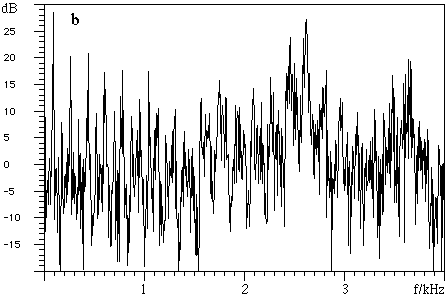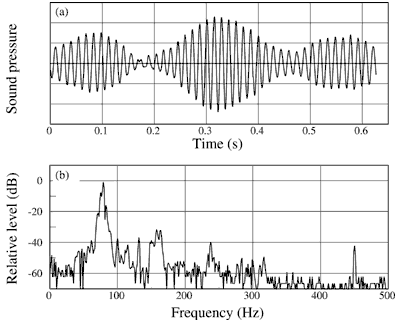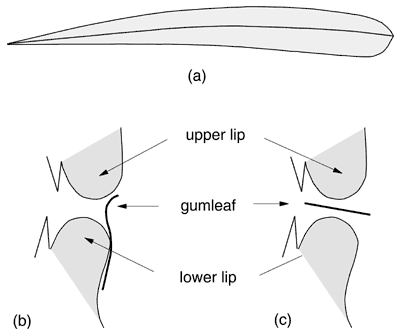| Australian Aboriginal Musical Instruments:
The Didjeridu, The Bullroarer And The Gumleaf* |
|
*Footnote: Presented at the Stockholm Music Acoustics Conference SMAC03 in August 2003 Neville H. Fletcher ABSTRACT The Australian Aboriginal people developed three musical instruments - the didjeridu, the bullroarer, and the gum-leaf. Most well known is the didjeridu, a simple wooden tube blown with the lips like a trumpet, which gains its sonic flexibility from controllable resonances of the player's vocal tract. The bull-roarer is a simple wooden slat whirled in a circle on the end of a cord so that it rotates about its axis and produces a pulsating low-pitched roar. The gum-leaf, as the name suggests, is a tree leaf, held against the lips and blown so as to act as a vibrating valve with "blown-open" configuration. Originally intended to imitate bird-calls, the gum-leaf can also be used to play tunes. 1. INTRODUCTION The Australian Aboriginal people have lived in this country, probably for more than 40,000 years, with almost no contact with the outside world. During that time they developed sophisticated tools such as the woomera spear-thrower and the returning boomerang. They also developed three musical instruments - the didjeridu, usually spelt "didgeridoo" in the non-academic literature and actually called a yidaki or yiraki in the Aboriginal language of the region where it originated, the bull-roarer, and the gumleaf. The didjeridu is a simple wooden tube blown with the lips like a trumpet, which gains its sonic flexibility from controllable resonances of the player's vocal tract. The bull-roarer, called by other names in Aboriginal languages, is a simple wooden slat whirled in a circle on the end of a cord so that it rotates about its axis and produces a pulsating low-pitched roar. The gum-leaf, as the name suggests, is a leaf from a Eucalypt tree, held against the lips and blown so as to act as a vibrating valve with "blown-open" configuration, denoted by (+,-). The sounding pitch is controlled by vocal tract resonances and is typically about an octave above the female singing voice. Originally intended to imitate bird-calls, the gum-leaf can also be used to play tunes. This paper will briefly describe each of these instruments. 2. THE DIDJERIDU The didjeridu originated in Arnhem Land on the northern coastline of central Australia, and has some similarity to bamboo trumpets and even bronze horns developed in other cultures, though it pre-dates most of these by many millennia. The characteristic feature is that the didjeridu, which is a slightly flaring wooden tube about 1.5 metres in length, is simply hollowed out by natural termites ("white ants") from the trunk of one of the small trees of the region. After cutting down, the instrument is cleaned out with a stick, the outside refined by scraping and then painted with traditional designs, and the blowing end smoothed by adding a rim of beeswax.
Figure 1. Spectra of didjeridu sound. (a) an uninflected drone, and (b) a drone with two prominent formant bands. (From [4]) The predominant sound of the didjeridu is a low-pitched drone with frequency around 70Hz, but depending significantly upon the length of the instrument and the flare of its bore. The second mode of the tube, with frequency a little less than 1.5 times that of the fundamental (because of the tube flare) is used sparingly as an accent to the sound, and the main variation comes from production of pronounced formant bands, the frequencies of which can be adjusted by the player over a range from about 1kHz to 3kHz, as shown in Fig. 1. In traditional use, the didjeridu, with clap-sticks for emphasis, accompanies songs or illustrates traditional stories about ancestors and animals [1]. Recently, however, its use has spread into the popular music domain and has had world-wide influence [2]. The acoustics of the didjeridu tube is simple. Because of the irregular shape and general slight flare, the upper resonances (impedance maxima) are not well aligned with odd harmonics of the fundamental, and the main determinant of quality is the smoothness of the walls, on a sub-millimetre scale, and the absence of cavities. The diameter of the blowing end, typically about 30mm, must also be a convenient match to the lips of the player. The real acoustic interest comes from the techniques by which unusual sounds are made [3]. The prime technique is one involving adjustment of the impedance maxima of the vocal tract, as judged from the vibrating lip valve, since this impedance is effectively in series with the comparable impedance of the didjeridu tube itself. The player achieves this adjustment by raising the tongue to narrow the airway near the lips and further adjusting the spacing between the rear of the tongue and the hard palate [4]. Some further results of research on this subject are presented in a recent paper by Wolfe et. al. [5]. The main reason that these techniques are so effective in the didjeridu, compared with other lip-driven instruments, is that the diameter of the instrument bore near the lips is quite similar to that of the upper vocal tract, and there is no intervening mouthpiece cup to isolate one from the other. The other impressive contribution to didjeridu sound comes from a technique in which vocalisation occurs simultaneously with normal lip-generated drone. There are then two pressure-operated valves, the vocal folds and the lips, acting in series upon the air flow. Because the operation of each valve is nonlinear, since the air flow is essentially governed by a Bernoulli equation, this generates multiple sum and difference frequencies n f1 ± m f2in the sound output [3]. If the player sings a note a musical tenth above the drone, so that f2 = (5/2) f1, then in particular the sub-octave f1 /2 is generated, giving a deep "growl". In addition, the player may insert many other transient sounds to mimic the cries of dingoes or birds, with marked dramatic effect. 3. THE BULLROARER Since there are no bull-like animals in Australia, this is a misnomer for the Aboriginal instrument, but the actual word used is "secret-sacred" and not shared with non-Aboriginal people. The instrument itself consists of a simple wooden slat, 30 to 40cm in length and 5 to 7cm wide that is whirled around in a circle on the end of a length of cord. The slat rotates under the influence of aerodynamic forces and generates a pulsating sound with a frequency typically around 80Hz. This sound is an important feature of Aboriginal initiation ceremonies. The instrument itself is by no means unique to Australia, and similar sound generators have been used by populations as diverse as those of ancient Egypt and the Inuit of Northern Canada. An Australian instrument is shown in Fig. 2. The aerodynamics of sound generation in the bullroarer has been described in detail elsewhere [6], and only an outline will be given here. Since the quasi-static aerodynamic forces and torques on the slat balance out over a single period of its revolution, the aerodynamic torque driving its rotation depends upon the rate of rotation itself. There is one rotation-inducing torque term that is linear in slat rotation speed, and also a drag term proportional to the square of the rotation speed, These lead to a threshold rotation rate that must be exceeded to begin the process, and then to an upper limit to the rotation rate. The steady angular rotation rate f of a rectangular slat of width W swung through the air on a string of length L with rotation frequency F can be shown to be approximately f = 1.1 LF/ W - 5 , where f and F are in rotations per second. Each rotation of the slat creates an oscillating flow dipole and, from considerations of symmetry, the dipole oscillation frequency, and thus the radiated sound frequency, is 2f. The radiated acoustic power P is approximately P = 3 (p/c3) H2V6 where H is the length of the slat, p is the density of air, c is the speed of sound in air, and V=2πLF is the speed of the slat through the air. From these two equations we see that wide slats produce sound of lower frequency but that the radiated power is independent of slat width. Sound frequency is, however, proportional to airspeed and thus to arm rotation rate, and the radiated power is a strong function of this arm rate. For typical conditions, the radiated power is a few milliwatts for an arm rotation rate of 120 r.p.m., which is about as fast as can normally be achieved. Sound radiation is nearly omnidirectional. Because the output power is a strong function of airspeed V, and the arm rotation is normally faster on the down-sweep than on the up, the sound pulsates with a frequency typically between 1 and 2Hz. There is an additional slower pulsation with a period of several seconds that derives from the fact that the slat rotation gradually twists the cord, providing a contrary torque which eventually stops the rotation and re-launches it in the opposite sense.
Figure 2. An Australian bullroarer. (From [6])
Figure 3. (a) The pressure waveform of sound from a bullroarer, showing typical pulsations. (b) Frequency analysis of this sound, showing low harmonic development. (From [6]) Analysis of the sound, as in Fig. 3, shows little harmonic development, the second-harmonic peak being about -30dB relative to the fundamental. The peaks are, however, somewhat broadened because of the variable rotational speed of a human arm. 4. THE GUMLEAF The gumleaf is altogether more primitive as a musical instrument, since it consists simply of a leaf, the shape of which is illustrated in Fig. 4(a), from one of the various species of Eucalypt trees growing throughout Australia, held against the lips using the fingers of both hands. It does, however, have a long tradition and culture [7]. In the normal playing configuration, shown in Fig.4(b), the leaf is held tightly against the lower lip and, in a bent shape, lightly against the upper lip [8]. It is stretched rather tightly between the two hands. When air pressure is applied through the mouth, it tends to lift the top of the leaf away from upper lip and allow air to escape, so in this sense the valve can be described as an "outward-swinging door", which is given the symbol (+,-), indicating the effect on the flow of applying pressure from the supply side (+) and from the exhaust side (-). Its configuration is thus similar to that of the valve constituted by the lips of a brass-instrument player, although these are sometimes (+,+) as in a sliding door, and the opposite of the reed of a clarinet, which is (-,+), as in an inward-swinging door. The acoustic behaviour of valves of each of these types has been examined elsewhere [9,10], and this treatment provides the basis for the present discussion. Although it takes a good deal of trial and error for a beginner to even produce a sound from a gumleaf held as indicated in Fig. 4(b) above, a skilled player can control the pitch with good accuracy over a range of more than an octave and play simple tunes with ease, the pitch range being typically from about 500 to 1000Hz. Interest therefore centres on exactly how this is done. Theory [9] and experiment [10] agree that for a valve with configuration (+,-) to oscillate, the sum of the up-stream and down-stream acoustic impedances must have a negative imaginary component. Since the downstream impedance is essentially zero in this case, this implies that the mouth and vocal tract must present a compliant (capacitive) impedance at the lips. When this condition is satisfied, the valve will oscillate provided the applied air pressure exceeds a certain threshold and the losses are not too great. The actual oscillation frequency is necessarily higher than the mechanical resonance frequency of the elastically braced leaf, and is further determined by the magnitude of the impedance presented by the mouth to the leaf. If the imaginary part of this impedance is negative and large, corresponding to a small enclosed air volume in the mouth and a narrow passage to the lower vocal tract, then the oscillation frequency of the valve will be much higher than its natural frequency. In many ways, then, the technique for varying the mouth and vocal tract when playing the gumleaf is similar to that used in whistling.
Figure 4. (a) The shape of a typical gumleaf from a Eucalypt tree. (b) In normal playing, the leaf is held firmly against the lower lip and rested lightly against the upper lip, and it is the upper edge of the leaf that vibrates. (c) A variant way of holding the leaf that results in a raucous quasi-chaotic sound. As the gumleaf valve opens and closes, so the pressure in the mouth falls and rises, with a phase advance of about ?/2 relative to the lip opening. Because the airflow through the valve is in turn proportional to its opening area and to the square root of the driving pressure, this nonlinear relationship generates harmonics of the fundamental frequency, and the sound is rich in upper partials and has an incisive quality. There is one other way of playing the gumleaf that is also worthy of mention. The configuration used is shown in Fig. 4(c), with the leaf simply lying parallel to the slot between the lips. As a variant, the leaf is sometimes held vertically between the sides of two opposed thumbs, which are pressed against the lips to create essentially the same configuration. The aerodynamic behaviour is now very different, and laboratory investigations suggest that the leaf, which is essentially flat, moves backwards and forwards in the slot and, at the same time, twists about its longitudinal axis. This motion repeatedly narrows and widens the flow channel at a frequency equal to twice the mechanical oscillation frequency of the leaf and so has a similar effect on the air flow and thus on the emitted sound. In a larger-scale laboratory experiment the motion could be made simple and regular, but in most playing situations the leaf makes irregular contact with the lips or the thumbs and this upsets the motion. The resulting sound, while having a predominant pitch, is rough and quasi-chaotic. It is useful for special effects, such as imitating the cry of the native sulphur-crested cockatoo [11], but has no obvious musical value. 5. CLAPSTICKS As in most cultures, the Aborigines also used percussive instruments in their ceremonies. Often these were simply two boomerangs clashed together, but they also made special shaped sticks for this purpose. Because the wood used is a fine-grained hardwood, the clapsticks are physically long-lasting and produce a sharp and well defined sound. In their usual form, these sticks are about 200mm in length and 20mm in diameter and are shaped to a long point at each end. One stick is held in each hand and they are struck together at about the mid-point of each. The pointed ends ensure that the fundamental transverse vibration has a high frequency, so that the percussive effect stands out well above the drone of the didjeridu. 6. CONCLUSION Ethnomusicology is a very interesting field, and it is made even more interesting when allied with a study of the acoustics of the musical instruments that were developed by the society under study. The musical instruments of the Australian Aboriginal people have come into world prominence because of the popularity of the didjeridu, both as a tourist item and as a musical instrument. It is only recently that we have begun to have an appreciation of the acoustical subtleties associated with performance on this and other ancient instruments. REFERENCES
Source for this article: Acoustics Australia, Vol 31 Ausgust (2003) No 2 Reprinted with permission of the author Neville Fletcher Read on: |
|
Home | About Us | Checkout | Community | Help | Information | Shopping Didj Forum | Send a Didj Greeting Card | Guest Book |
| © Didjshop.com, 1993-. For rights reserved and granted see our Copyright notice. |





